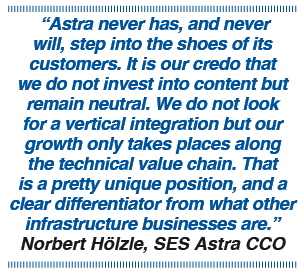Insight... SES ASTRA... Dramatically Transitioning Beyond Europe
 SES Astra dominates the delivery of DTH (Direct-to-Home) television over three major EU markets: Germany, the UK, and France. But when you have near 100 percent saturation, where do you go next? Astra’s recently appointed CCO Norbert Hölzle has some very decisive plans to win further market share within Europe and well beyond its borders.
SES Astra dominates the delivery of DTH (Direct-to-Home) television over three major EU markets: Germany, the UK, and France. But when you have near 100 percent saturation, where do you go next? Astra’s recently appointed CCO Norbert Hölzle has some very decisive plans to win further market share within Europe and well beyond its borders.

“We are leader in key markets and in digital, that`s true. But there are two reasons why we cannot rest: First of all, we look for growth and therefore expand into new, dynamic markets, even beyond Europe. And secondly, we want to further benefit from the head start we had in digital and develop the premium television that we are able to deliver, and that means: push HD and push 3D. Astra will strengthen its position as
THE player in the digital world.”
 Hölzle
Hölzle recognizes the challenges ahead, but compares many of them with the position in the highly competitive telco world, where he has considerable experience. “If you’re just selling capacity on any telco, then you cannot succeed. It is the same with us at Astra. We need to be seen as much more than just the supplier of capacity in the industry. We can do so much more, and we will have some more excellent deals to announce in the near future.
“Our thinking has changed dramatically,” he states, adding that visitors to Astra’s IBC stand in September saw a strong flavour of how the strategy was altering. “Everything that we showed the client was digitally displayed, we had a massive screen that interactively showed how our satellites are looking at the world and as with the iPhone, you could expand or move to another position just with a finger touch. And this is at the root of the new look for Astra and how we want to talk to our customers about our view of business today and the opportunities for tomorrow. For example, what do we have to do to show them how very fast we can provide capacity on an end-to-end basis and to include ground stations and everything else? What I have to say is that as the incumbent we have to have and show a detailed knowledge of our industry, and I believe we have done that at IBC.
“Of course, satellite remains at the heart of our proposal: a high performing digital infrastructure. But we take an integrated view, what we provide is solutions, on an end-to-end basis, including ground stations and everything else that broadcasters need. We talk to our customers about their business today and the opportunities for tomorrow,” he stresses.
Hölzle recognized that most of Europe’s public and commercial free-to-air broadcasters, and especially those in Germany, need a new economic and business model to finance the extra costs of HDTV – and 3D. “It is for this reason that
SES Astra introduced the HD+ platform. The objective of this was simply to allow also free-TV broadcasters to realize an HD business. They like the idea, not because they like us, but because it’s common sense and they refinance their investment in HD.
Furthermore, they make sure that broadcast TV remains the most important entertainment medium. I compare the digital world with the mobile industry. What HD+ does is comparable to the concept of a mobile phone. HD+ places a card like a Sim card at the consumer premises, and using that card in your receiver you can find and access your content and benefit from extra value from the broadcasters. As a broadcaster, you can deliver this extra value. This direct bridging between broadcaster and customer is a big change in our thinking.”
Astra has enjoyed the fruits of the HDTV boom. Now it is preparing for 3D.
 Hölzle:
Hölzle: ”We are extremely active supporters of 3D. We have already held 3D forums in Luxembourg, helped by our customers, we have seen 3D being broadcast live and can see the instant benefit that it offers. There are still sceptics out there who think that the obligation to wear glasses is a problem but I think the industry is now much more relaxed and understands that viewers are perfectly happy to wear 3D goggles for hours. And even when the 3D transmission ends, people keep the goggles on! We realized at IBC that talking about HD is not as much fun as looking at HD and it is the same with 3D, talking about 3D is not as much fun as viewing 3D. For us at Astra, it’s not a question of whether it’ll happen, it’s already happening. The bigger question ‘how much an impact will 3D have?’ is more difficult to quantify but I see it happening. Our customers and ourselves are putting considerable effort behind 3D and I believe that their and our strategies are the right ones.“

SES has itself expanded far beyond its Luxembourg base. But Astra also has to seek out new markets, and products. Some might criticize SES for concentrating on expansion through acquisition and allowing local rivals, notably Eutelsat and Telenor. “We have to recover our position in these markets and in some of them we are not even the big Astra, we are the aggressor, not the incumbent. But have no doubt we know how to act as the aggressor and you will see a very different Astra compared to the past. Just before IBC we agreed on a new strategy and this will see us play much more of a market game in Eastern Europe. Otherwise, the industry will pass us by totally. We [recently] signed a DTH deal in Croatia .We have to run faster than the others to get back into the game.
“SES Astra has to grow in all of its markets but especially in Central and Eastern Europe, in the Middle East and in Africa, especially in South Africa and Kenya,” admits
Hölzle. “It will come as no surprise that we intend attacking our competitors in those markets very heavily indeed. We will grow in these areas which we consider to be our backyard. And we will run fast to win the game!”

This is undoubtedly fighting talk, but it also reflects a quite dramatic change of pace at SES. While it is true to say that they will never set up as a broadcaster in competition with their own clients, that ‘rule’ does not apply to virgin markets. One such region is sub-Saharan Africa, and SES Astra has recently taken a stake in On Digital Media, which trades out of Johannesburg as TopTV. TopTV offers viewers a low-cost DTH bundle and directly competes with giant incumbent DStv, part of the MultiChoice empire.

Astra’s strategy is explained by
Hölzle: “Take a moment to look at the basics of this industry where a client might come and knock at our door and ask what can we offer. In the past we have offered capacity and expertise and the potential client would say ‘yes, but Eutelsat can offer that as well’. So, as a capacity seller, I have three options: I can undercut the price being charged in the market, which will lead to my rival undercutting me and we will both kill ourselves in the process so this is not an option for Astra. My second argument would be that our quality is the best in the market, this is true but is the client willing to pay for this superb service? Or third, I can say that we can provide you with a one-stop shop of end-to-end solutions where I can manage your content, play out your content and while this is not my core business model, I can help you bring your product to market easily and speedily. And this is our preferred option: we like working with clients, offering a one-stop shop, getting them to our viewers’ screens and I can tell you this philosophy is very interesting to many clients. This even applies to large players like Canal+ which, while it has an excellent position in its home market, wants to reach beyond that market. The fact is that there are plenty of people out there who can offer playout, and media management but they may not have a clue as to how to really set up a channel, how to achieve satellite distribution or marketing of their channel on DTH.
“Besides selling pure capacity, we like to offer B2B and other services to get the player on air. We can even help our customers at our own cost. We see this as a necessary entry fee in getting this customer on its feet. We won’t dump prices but I will certainly spend market entry money to help these new clients for DTH and B2B marketing.


“Then there’s another new territory, the Middle East, where Astra has craftily partnered with the YahSat operators out of Abu Dhabi. “Even in the recent financial crisis that affected the whole of the Middle East, Abu Dhabi came out of it much stronger. However, we are realistic about the Middle East, this will not be an overnight success. We are going to have to work hard to achieve our goals and the Middle East will take time,” adds
Hölzle.
And the future: “ I don’t have much that I can add other than my core building blocks: we want to lead in the digital world, secondly, we have to become a good partner for the telcos and create packages for them and even help market boxes for them. The third is that we will have market entry strategies creating indirect sales channels on the ground, offering prices that are appealing and attractive to different types of users and fourth, I want to build on the relations we have with our existing customers to move them out of their home markets, growing with them as they expand overseas.”


